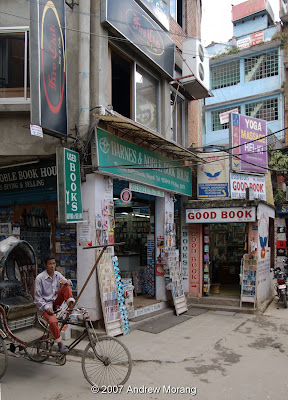

This Urban Decay decay essay will take you about as far from New York City as possible: about 180 degrees in longitude around the world, 1300m higher in elevation, no ocean, 2000 years older, and vastly different in culture. Our destination is Kathmandu, the bustling landlocked capital of Nepal, a mountainous country squeezed between Tibet and India and dominated by the Himalaya. Kathmandu is an urban area of about 1.5 million inhabitants in the Kathmandu Valley in central Nepal, along the Bagmati River. Because of the fertile, well-watered land and the relatively comfortable climate (cooler than the sweltering Indian lowlands and warmer than the high Himalaya), the valley has been inhabited for millenia. As you can see from the signpost (photographed at the Kathmandu Guest House, a fun place to stay in the Thamel District), it is a long way from anywhere.
To reach Kathmandu, you fly from a US gateway city, cross the Atlantic or Pacific, wait at an Asian gateway city for hours, and then fly again, on and on and on. You finally reach Tribhuvan International Airport very grubby and jet-lagged and feeling pretty beat up. Your fellow passengers largely fit into three groups: local citizens (often workers on their way home from jobs in the Gulf states), hikers and climbers, and "adventure" travelers. The latter are the type who wear safari clothing and multi-pocket travelers' vests (but nothing is in the pockets), and have more luggage than the true climbers.


Most tourists stay in or congregate in the Thamel District. This was a popular stop-over on the Asia circuit in the 1970s. Hippies loved it because living was cheap, drugs were cheap and readily available, and it was trendy ("I'm going to be creative and unique and go to Nepal along with thousands of other hippies."). Oddly, some are still around, but a bit grayer and chubbier now. The district throbs with discos (yes, disco still lives), internet cafes, restaurants, shops, and bars. They even have their own Barnes & Noble book house. The pharmacies are well-equipped and most chemicals are sold without prescription. The supermarkets sell chocolates from around the world; the bookstores stock magazines and books in many languages. Another oddity: Nepal's time zone is GMT +5:45 hours (15 min different than India). This is the link to Google maps:
Thamel.


Everything about Kathmandu is a visual delight. The buildings are colorful, rather funky, and have a somewhat makeshift look to them. Parts have been added to parts, colors are all over the spectrum, and the glass box monstrosities of US and European cities are largely absent.

Don't look too closely at the electrical wiring. Some of the outlets are the odd triple prong type used in India, others are the narrow dual-prong from Europe. The electricity was dependable during my visits.

The people are absolutely wonderful. This little girl kept her father company in his fabric shop.


Kathmandu is a city of shops, and you can find almost anything you need with a bit of hunting. But many vendors are out in the street. Pay attention when you walk on a sidewalk or you will fall over a merchant or stomp on his display.


The people I met were unfailingly friendly and gracious. They are alert and energetic. The ladies are petite and sophisticated.
(More Nepal in future essays. All 2007 photographs taken with an Olympus E-330 digital camera or a Fuji F31fd compact.)









